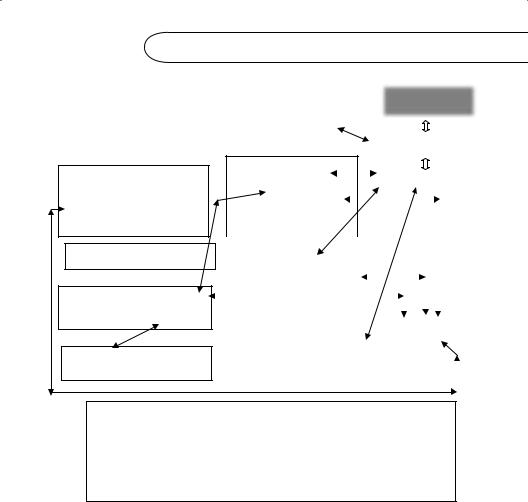
- •Contents
- •Series Preface
- •Acknowledgments
- •RATIONALES UNDERLYING NEPSY AND NEPSY-II
- •NEPSY DEVELOPMENT
- •NEPSY-II REVISION: GOALS AND DEVELOPMENT
- •COMPREHENSIVE REFERENCES
- •CONCLUDING REMARKS
- •APPROPRIATE TESTING CONDITIONS
- •TYPES OF ASSESSMENTS
- •ASSESSING CHILDREN WITH SPECIAL NEEDS
- •OTHER ADMINISTRATION CONSIDERATIONS
- •SUBTEST-BY-SUBTEST RULES OF ADMINISTRATION
- •COMPUTER SCORING
- •PREPARATORY TO SCORING
- •ORDER OF SCORING
- •STEP-BY-STEP SCORING
- •TESTS WITH COMPLEX RECORDING AND/OR SCORING
- •QUICK-SCORING: DESIGN COPY GENERAL (DCG)
- •DESIGN COPYING PROCESS (DCP) SCORING
- •OVERVIEW OF SUBTEST SCORES
- •SUMMARIZING NEPSY-II SCORES
- •CONCLUDING REMARKS
- •GOALS OF INTERPRETATION AND IMPLEMENTATION OF GOALS
- •STEP-BY-STEP INTERPRETATION OF NEPSY-II PERFORMANCE
- •INTRODUCTION
- •TEST DEVELOPMENT
- •STANDARDIZATION
- •PSYCHOMETRIC PROPERTIES
- •ADMINISTRATION AND SCORING
- •INTERPRETATION
- •OVERVIEW OF STRENGTHS AND WEAKNESSES
- •THE NEPSY-II REFERRAL BATTERIES
- •DEVELOPMENTAL DISORDERS AND NEPSY-II
- •EVIDENCE OF RELIABILITY IN NEPSY-II
- •CONVENTIONS FOR REPORTING RESULTS
- •RELIABILITY PROCEDURES IN NEPSY-II
- •CONCLUDING REMARKS
- •CASE STUDY #1: GENERAL REFERRAL BATTERY
- •CLINICAL IMPRESSIONS AND SUMMARY
- •PRELIMINARY DIAGNOSIS
- •RECOMMENDATIONS
- •DIAGNOSIS
- •Appendix: NEPSY-II Data Worksheet
- •References
- •Annotated Bibliography
- •About the Authors
- •Index

HOW TO SCORE THE NEPSY-II 183
(See Table A.1 in the Clinical and Interpretive Manual to obtain the WI Repetition and the WI Recall Scaled Scores.)
Contrast Scores:
The WI Repetition vs. Recall Contrast Scaled Score compares the child’s performance on Repetition to the child’s performance on Recall.
(See Table C.14 in the Clinical and Interpretive Manual to obtain the WI Repetition vs. Recall Contrast Scaled Score.)
Behavioral Observation:
Total the number of Asks for Repetition(s) that occurred during the Word List Interference subtest.
(See Table D.1 or D.4 in the Clinical and Interpretive Manual to obtain the Asks for Repetition Total Cumulative Percentage.)
SUMMARIZING NEPSY-II SCORES
The NEPSY-II Score Summary by Domain is found on the front page of the Record Form. Not all of the scores from each test are summarized here, but the Primary Scaled Scores, including some Combined Scores, are graphed and also some Process Scores. Simply transfer the designated scores from the appropriate scoring box to the summary sheet. This will allow you to compare key results with and across domains.
The NEPSY-II Behavioral Observations Summary is found on the inside front page of the Record Form. Simply transfer the Behavioral Observation raw score to the bubble beside the appropriate subtest area under the correct domain. Then transfer the Cumulative Percentage or the Percent of Standardization Sample as they appeared when you scored the Record Form to the scoring box beside the bubble. In some cases, you enter Y or N for presence or absence of a Behavioral Observation.
These summaries provide a way to “eyeball” the data and for parents to see how a child performs compared to the typical child of his or her age. They can be a very helpful adjunct to the clinician’s report.
Finally, it is important to remember that it is not necessary to calculate and consider all process, combined and contrast scores for the subtests that have been administered. These may be regarded as optional, supplemental scores. However, they provide qualitative data that make the picture of the child’s abilities and stumbling points much richer and may provide a fuller understanding of the child’s situation.

184 ESSENTIALS OF NEPSY-II ASSESSMENT
CONCLUDING REMARKS
Scoring is somewhat of a mechanical process, but it is essential to the validity of the clinician’s interpretation of the child’s performance that it be handled professionally and with precision. The process of interpretation begins, of course, with administration, as one observes the child’s performance and begins to form hypotheses concerning the presenting problem(s). Interpretation continues as the clinician scores and formulates further hypotheses and/or verifies previous hypotheses or rejects them. The scores come alive through this process. In the next chapter, interpretation of a child’s scores will be presented, along with how one identifies diagnostic clusters and verifies results. These are crucial steps in any assessment process and can have an enormous impact on the ultimate outcome for the child being assessed.
S
TEST YOURSELF
S
1.The subtests that are more difficult to score than most are (check all that apply):
(a)_____ Memory for Names.
(b)_____ Inhibition
(c)_____ Phonological Processing.
(d)_____ Design Copying.
(e)_____ Auditory Attention and Response Set (AARS).
(f)_____ Arrows.
(g)_____ Speeded Naming
(h)_____ Clocks
FILL INTHE BLANKS ANDTRUE/FALSE
2. A Commission Error on AARS can also be an inhibitory error
(a) true_____ |
(b) false_____ |
3.The Design Copy Process Scoring Total Score comprises three scores: DCP Motor Score that reflects fine motor control in copying designs;
DCP Score that reflects______________________ ; and the DCP Score that reflects______________________________ .
4.A pencil mark went outside the track in VMP and came back into the track in the next segment. It would count as _______________
errors.

HOW TO SCORE THE NEPSY-II 185
5.The ________________ confidence interval is recommended when one is computing statistical differences.
6.A performance >75% of the standardization sample would be described as being ____________________ according to the NEPSY-II Manual.
7.A cumulative percentage of 10 would be interpreted as “the child’s score is better than 10% of his or her age group.”
(a) true _____ |
(b) false_____. |
MATCHING
8. |
_____ A scaled score of 4 |
a. |
most important age-corrected scaled |
|
|
|
scores for each subtest |
9. _____ A base rate of 4 |
b. |
Above Expected Level |
|
10. |
_____ A scaled score of 14 |
c. |
express different aspects of |
|
|
|
performance |
11. _____ Primary score |
d. |
Below Expected Level |
|
12. |
_____ Type 1 error |
e. |
more than the designated number of |
|
|
|
cards placed in the grid |
13. |
_____ MD Rule violation |
f. |
At Expected Level |
14. |
_____ Process scores |
g. |
avoid by validating scores with evidence |
|
|
|
from child’s daily life |
15. |
_____ 26–75% |
h. |
“4% of the same-age children obtained |
|
|
|
the same score or lower.” |
Answers:
1. b, d, e, g, h; 2. true; 3. (Answers can be in any order) Global—refl ects accuracy in reproducing confi guration of design; Local—refl ects accuracy in reproducing the design details; 4. 2; 5.
.95; 6. above expected level; 7. False. This would be the interpretation of a score at the 10th percentile rank; 8. d; 9. h; 10. b; 11. a; 12. g; 13. e; 14. c; 15. f

Four
HOW TO INTERPRET THE NEPSY-II
This chapter presents a systematic method of interpreting NEPSY-II. After the discussion of some background concepts, the three goals of interpretation and their implementation will be discussed in depth. Interdomain
and Intradomain differences at the subtest level, as well as the meaning of such differences, will be discussed, and interpreting various scores and quantifying Behavioral Observations as a means of teasing apart a problem will be presented. Finally, the chapter will discuss the integration of results and patterns of findings that Bernstein and Waber (1990) have termed “diagnostic behavioral clusters.”
GOALS OF INTERPRETATION AND IMPLEMENTATION OF GOALS
The First Goal: Consider and Describe Strengths and Weaknesses
The first straightforward goal of NEPSY-II interpretation is to consider the child’s neurocognitive development comprehensively. Implementing this goal involves not only looking at the child’s performances in terms of psychometric test scores, but interpreting the data in terms of the child’s strengths and weaknesses as well as needs.
Interpretation at this level accomplishes the first goal of considering the child’s neurocognitive development comprehensively. The clinician develops a comprehensive overview of the child’s neurocognitive development through the NEPSY-II test profile and assesses the child’s strengths and weaknesses. This level of interpretation may be an end in itself or the first step in the next level of interpretation. A psychologist without special training in neuropsychology may feel comfortable in drawing these kinds of conclusions. The purpose of any evaluation in the final analysis is to provide a basis for rehabilitation and/or intervention plans. The results at this level of interpretation are interpreted for “behavior-behavior relationships” (Taylor & Fletcher, 1990). For example, the clinician might discuss
186

HOW TO INTERPRET THE NEPSY-II 187
a child’s reading disability in terms of his poor performance on the Phonological Processing subtest in comparison to other children his age. Interpretation at this level is carried out in three steps: (1) describing the child’s performance in comparison to the normally developing child of his or her age, (2) looking at the child’s performance in terms of his or her own functioning, and (3) relating these results to observed areas of difficulty in learning or in everyday life. This last part of the interpretation is the ultimate goal of all neuropsychological assessments.
How the Child Functions in Comparison to the Typical Child of His or Her Age in the NEPSY-II Standardization Population
First, examine psychometrically the profile of primary, process, and contrast scores, percentile ranks, and cumulative percentages derived from the assessment, comparing the child’s performance to the NEPSY-II subtest mean of 10 + 3. The subtest mean on NEPSY-II reflects the performance of the typical child on any of the NEPSY-II subtests. Comparison is also made to the descriptive classification levels for scaled scores and percentile ranks. (See Rapid Reference 4.1 for descriptive classification of scores.)

 Rapid Reference 4.1
Rapid Reference 4.1
Qualtitative Descriptions of Scaled Scores and
Percentile Ranks
Scaled Score |
Percentile Rank |
Classification |
13–19 |
>75 |
Above Expected Level |
8–12 |
26–75 |
At Expected Level |
6–7 |
11–25 |
Borderline |
4–5 |
3–10 |
Below Expected Level |
1–3 |
≤ 2 |
Well Below Expected Level |
Some qualitative Behavioral Observations are quantified on NEPSY-II so that the percentage of children in the standardization sample who displayed this behavior can be used as a reference point for interpreting a child’s performance. Cumulative percentages (base rates for age) and the percent of the Standardization Sample Displaying a Specific Behavior may also be used. These are found in Appendix D of the Clinical and Interpretive Manual of NEPSY-II. (See Rapid Reference 4.2.)

188 ESSENTIALS OF NEPSY-II ASSESSMENT

 Rapid Reference 4.2
Rapid Reference 4.2
Appendix D
Behavioral Observations Are Quantified on NEPSY-II
•Cumulative percentages (base rates for age) or the percent of the Standardization Sample displaying a specifi c behavior are found in Appendix D of the Clinical and Interpretive Manual.
•These may be used as a reference point for interpreting a child’s performance.
How the Child Performs in Terms of His or Her Own Functioning on NEPSY-II
The second step is to describe the child’s relative strengths and weaknesses in terms of his or her own functioning on NEPSY-II. The clinician will focus on how the child’s performance on a particular task was deviant from the child’s performance on other subtests within and across domains. The clinician describes the strongest subtest results, the weakest, and those that fell in between. As there are many possible scores, there is a need to be critical in order to avoid Type 1 errors, which is to see weaknesses when there actually are none. Psychological assessments are influenced by many situational factors—for example, the child may lose interest or be momentarily thinking of something external to the task. The likelihood of some sporadic poor test findings is greater the more subtest scores we end up with. Therefore,
when describing the test profile, strengths or weaknesses that appear in a consistent fashion over several scores or observations are the ones of interest, not single findings that appear to be isolated or sporadic.
Relate the Child’s Performance to Observed Areas of Difficulty in School and in Everyday Life
Finally, the third step in interpretation at the descriptive level is to relate the child’s performance not only to that of age peers, and to his or her own pattern of strengths and weaknesses, but also to observed areas of difficulty in school and

HOW TO INTERPRET THE NEPSY-II 189
in everyday life. An example of behavior-to-behavior relationships (Taylor & Fletcher, 1990) in interpretation is seen here:
EXAMPLE (One segment of a full report, not meant to imply conclusions were based on one subtest): Ricky, age 7, displayed a significantly poor performance (PP scaled score 5) on the Phonological Processing subtest in relation to the NEPSY-II subtest mean (10 + 3) for a child of 7 years. This result suggested a deficit in the phonological awareness that has been shown in numerous studies across the years to underlie efficient reading decoding and spelling (Betourne & Friel-Patti, 2003; Bishop & Snowling, 2004; Bradley, 1989; Fraser & Conti-Ramsden, 2008. Ricky also displayed a relative weakness in phonological awareness in terms of his own average performance on NEPSY-II subtests overall (Personal mean = 11 + 3), suggesting that this is an area that is apt to cause him significant difficulty in school and everyday life in relation to his other abilities. These results relate to background history collected from Ricky’s teachers and family. His parents have noted, and Ricky’s teachers have reported, marked struggles in reading decoding and spelling since reading instruction began last year. In particular, he has struggled with phonics. Family history revealed that a paternal uncle was diagnosed as dyslexic in childhood, although he had overcome his reading problems by middle school. This background information lent support to the finding of a deficit in phonological awareness, one of the core symptoms in dyslexia. (Rapid Reference 4.3 provides guidelines for describing strengths and weaknesses.)

 Rapid Reference 4.3
Rapid Reference 4.3
Interpreting by Describing Strengths and Weaknesses
1.Describe child’s strengths and weaknesses compared to development of typical child of his or her age in standardization population (scaled score mean = 10 ± 3).
•Remember strengths are as important as weaknesses.
2.Describe child’s relative strengths and weaknesses compared to his or her own functioning (personal subtest mean across/within domains).
•Remember the diagnostic essence of NEPSY-II is at the subtest level.
3.Relate child’s NEPSY-II results to behavioral observations and to developmental, medical, family, educational, and emotional history.
•Use behavior-to-behavior relationships (e.g., relate child’s poor Phonological Processing results to his or her weak reading decoding skills).

190 ESSENTIALS OF NEPSY-II ASSESSMENT
The Second Goal: Specify and Analyze the Child’s Impairments
The second goal of interpretation is to identify impairments, and wherever possible, to analyze the child’s impairments (Korkman, Kirk, & Kemp, 2007). The first step at this level aims to discover what function is specifically impaired, while the second step addresses the question of why a particular activity is so difficult for the child (Korkman, 1999). A third step in the clinical interpretation may answer the question, which disorder might be present, based on a recognition of diagnostic behavioral cluster composed of the observed primary and secondary impairments. A diagnostic behavioral cluster is not always present, however. The clinician should then analyze the specific impairments instead. The clinical level of the interpretation process involves three separate steps, described as follows:
Identify Specific Impairments
To do so, the clinician must delineate some aspect of performance derived at the descriptive level on which the child tends to exhibit specific problems in a fairly consistent fashion. Such impairments need to meet certain criteria, that is, they are demonstrated:
(a)When specific subtests in one domain are impaired both in relation to the age norm and in relation to the child’s results in other domains.
EXAMPLE: Specific impairments of this type are language impairments, attention problems, social perceptual differences, sensorimotor problems, or visuospatial impairments. These disorders, which may affect subtests in one domain differentially, will often show effects on the subtests of other domains (e.g., a language impairment affecting verbal memory performance).
(b)When two or more subtest scaled scores, percentile ranks, or Behavioral Observations within a domain or across domains indicate that a certain aspect of performance is impaired either in relation to the age norm or in relation to the child’s own mean.
EXAMPLE: An example of consistent findings across domains is when a child has weak scores on the Inhibition subtest and on the Response Set task of the AARS subtest in the Attention/Executive Function domain, and also performs poorly on the List Learning subtest in the Memory and Learning Domain due to a flat learning curve. Together, these findings suggest executive dysfunction related to planning, programming, and monitoring performance.
Another example might be dysnomic or semantic problems evident on the Speeded Naming and Comprehension of Instructions subtests in the Language Domain, but also the Memory for Names and Narrative Memory subtests in the Memory and Learning domain, all of which suggests a language

HOW TO INTERPRET THE NEPSY-II 191
problem with associated verbal memory deficits and deficits of name learning or retrieval.
Finally, a third example would be motor coordination problems that may affect not only sensorimotor tasks, such as Fingertip Tapping and Visuomotor Precision, but also the Design Copying subtest in the Visuospatial domain, despite good visuospatial skills on Geometric Puzzles, which has no motor component.
This step in interpretation differs from the more straightforward behavioral interpretation of findings at the descriptive level. Interpretation at this level is richer if the clinician has current knowledge of patterns to look for based on familiarity with the pediatric neuropsychological research. Identifying specific impairments is not exactly the same thing as defining strengths and weaknesses behaviorally. The problem may be more subtle or complex than describing a behavior in relation to the norm. It often takes place through error analysis. The more neuropsychological training and expertise a clinician has, the more skillful he or she is in inferring the role of deficits. (See Rapid Reference 4.4.)

 Rapid Reference 4.4
Rapid Reference 4.4
Interpretation at the Clinical Level
The three steps of the interpretation process at this level are:
1.To identify specifi c impairments.
2.To analyze specifi c impairments.
•Analyze separately, as far as possible, the subcomponents known to be a part of that function.
•Specify and discuss what part of the process is defi cient.
•Specify and discuss primary and secondary defi cits.
3.Identify diagnostic behavioral clusters that characterize particular diagnostic groups.
•Look for a diagnostic behavioral cluster to describe a disorder.
•Just because a cluster of symptoms is present does not necessarily mean a disorder is present.
•Interpret by anatomic axes only with neuropsychological training.
•Do not propose focal brain lesions or dysfunction and assume such only if there are clear neuroimaging data to suggest this.

192 ESSENTIALS OF NEPSY-II ASSESSMENT
Analyze Impairments by Specifying Primary and Secondary Deficits, Whenever Possible
The impairments the clinician identifies should be further analyzed to determine why the function was impaired.
(a)Analyze separately, as far as is possible, all subcomponents that are known to be a part of the function in question. In the Lurian tradition, specific NEPSY-II subtests represent subcomponents of complex processes. For instance, the NEPSY-II subtests Phonological Processing and Comprehension of Instructions address receptive language deficits. Studies have shown that receptive language deficits include errors when discriminating among phonemes, morphemes, and other speech sounds, particularly when a task is complex or involves high memory load (Bishop & McArthur, 2005; Burlingame, Sussman, Gillam, & Hay, 2005; Coady, Kluender, & Evans, 2005). Expressive language deficits are apparent, for example, as restricted expressions in narration and impaired word finding (American Psychiatric Association, 2000; Klee, Stokes, Wong, Fletcher, & Gavin, 2004). The NEPSY-II subtests that address such problems include holding a verbal sequence in memory long enough to process its content (Sentence Repetition subtest); attaching verbal labels to things and concepts, and retrieving them smoothly (Speeded Naming, Inhibition Naming, Memory for Names); as well as organizing articulatory sequences (Oromotor Sequences) and the details of a narration (Narrative Memory) (American Psychiatric Association, 2000). In a similar way, the clinician can analyze subcomponents used in the organization of other complex tasks: visuomotor performance, reading, solving arithmetical problems, and so forth (Korkman, Kirk, & Kemp, 1998, 2007).
(b)Specify what particular part of the process is deficient and whether the deficit contributing to the dysfunction is primary or is secondary to another deficit. The Lurian view, upon which NEPSY was originally based, and upon which, along with other theoretical substrates, NEPSY-II rests as well, suggests that cognitive capacities are functional systems composed of basic and complex interactive subcomponents (Christensen, 1984; Luria, 1973, 1980). Therefore, a primary deficit in one functional system could affect performance in other functional systems, causing secondary deficits. For example, on the NEPSY-II List Learning subtest, the child may be unable to learn a long list of isolated words, due not to a language disorder, but to executive dysfunction. The child cannot organize and monitor the mental list as he or she hears the words repeated. On the other hand, verbal working memory deficits (phonological and functional working memory) may be a clinical marker for language disorders and may be related to morphological and lexical language deficits (Montgomery, 2003). On the NEPSY-II Narrative Memory subtest, for example, children with language difficulties may have problems telling

HOW TO INTERPRET THE NEPSY-II 193
a story after hearing it, not because of a memory problem per se, but because of a language disorder. In this case, the verbal memory problem is secondary to the child’s language disorder. Each subcomponent performs its role in the chain of subprocesses. When one of them is deficient, the whole functional system may be disturbed. On the other hand, a disorder such as dyslexia may have more than one underlying deficit.
Kaplan’s (1988) view, that a process approach to assessment can provide information about a child’s problem that cannot be obtained from an analysis of primary scores alone, also underlies NEPSY-II. Therefore, where Primary Total Scores are provided, NEPSY-II often provides Process Scores, as well, so that different aspects of a global score can be considered separately (e.g., speed and accuracy) in order to facilitate identifying and interpreting primary and secondary deficits. For instance, the clinician can break down the Speeded Naming Combined Scaled Score that integrates time to completion on the test overall with overall accuracy by inspecting the Total Completion Time and the Total Correct. In this way, the clinician can consider whether a naming deficit is evident, or whether the child is slow in accessing words, or both. A naming deficit might be further confirmed by a weak performance on the Memory for Names performance and/ or on the Inhibition Naming condition of the Inhibition subtest. A more generalized processing speed problem, on the other hand, might be supported through inspection of Visuomotor Precision Total Completion Time and other timed tests that were administered, for instance, from the WISC-III or the DAS-II.
After Administering the Appropriate Subtests, the Clinician Should Analyze the Findings by Determining the Deficient Subcomponent That Appears to Cause the Overt Dysfunction
Because all human performance is more or less complex, most test results will depend on many capacities. For example, on the NEPSY-II Arrows subtest in the Visuospatial domain, the child must judge the orientation of lines and angles by pointing to the two arrows that will hit the target on each item. The child needs not only to perceive and judge the direction and orientation of the arrows correctly, but also to attend to the lengthy task and to look actively at each of the eight arrows before responding. Sometimes a poor performance on the Arrows subtest is the result, not of poor visuospatial perception, but of poor visual attention or executive dysfunction. The former problems would be characterized by the child’s inability to focus attention on the task or to sustain attention across the task. The latter could lead to responding impulsively, because the child could not inhibit the impulse to point to the first two arrows seen. In this case, the primary deficit would be visual inattention or a more pervasive dysexecutive function if

194 ESSENTIALS OF NEPSY-II ASSESSMENT
many executive functions were affected. A secondary effect would be weak ability to perform on visual tasks requiring focused attention. Underlying primary deficits may have to be inferred in this way, by using error analysis and looking at the pattern of findings.
Specifying primary deficits in children is complicated by the high degree of comorbidity of deficits (e.g., Watemberg, Wasserberg, Zuk, & Lerman-Sagie, 2007; Willcutt, Pennington, Olson, & DeFries, 2007). When a child suffers from several co-occurring deficits, such as an attention disorder and a language disorder, both of which can affect many types of performance, it can be difficult to specify primary and secondary weaknesses. Inattention affects language processing, but poor language processing can contribute to inattention. In these cases, it may be sufficient to provide a comprehensive description of the child’s neurocognitive status. The clinician may not always be able to specify primary and secondary deficits. In such instances, one may have to describe the total test profile and identify specific impairments, but not perform an in-depth analysis of the disorders.
Identify Diagnostic Behavioral Clusters That Characterize Particular Diagnostic Groups
Bernstein and Waber (1990) discuss the need to locate “diagnostic behavioral clusters.” This term refers to the process of recognizing specific patterns that usually characterize different diagnostic groups, such as children with ADHD, dyslexia, autistic spectrum disorders, Fetal Alcohol Syndrome, Asperger’s Syndrome, William’s Syndrome, and so forth. Such disorders may be of neurological, genetic, or unknown etiology. The identification process is based primarily on clinical expertise and knowledge of the literature, and, secondarily, on the pattern of the child’s specific psychometric scores.
The fact that a child shows a pattern of scores similar to that seen in a disorder does not necessarily mean the child has the disorder. Unless the child’s functioning is consistent with the disorder and the medical, genetic, and environmental factors that are consistent with the disorder are present, the disorder should not be identified. For instance, a girl might have a visuospatial deficit and a math learning disability, but be very sociable, maintain good eye contact, and be expressive during the evaluation. Her history reveals that she has many friends and participates successfully in several group activities. In this case, identifying Nonverbal Learning Disability would be inappropriate, because there is no evidence of social perceptual difficulties.
Sometimes, however, the parent may not report a family history of the disorder because he or she has forgotten about it, is embarrassed, or did not make the connection between the child’s problem and the presence of a similar problem

HOW TO INTERPRET THE NEPSY-II 195
in a member of the extended family. These are the kind of cases in which the importance of the diagnostic interview, the depth of the clinician’s knowledge of the literature, and the level of clinical insight can prove most valuable.
EXAMPLE: Suppose that Sonia has been referred for an evaluation of a reading problem. Achievement testing shows particular difficulty with reading decoding and spelling. There is no record of any familial dyslexia or reading problem on the history form. You notice, however, that there are many misspellings on the history form that was filled out by Sonia’s mother, who has a college degree. In your diagnostic interview you ask if there was anyone in the family who had a reading difficulty, and the response is negative. But when you ask if anyone had or has trouble pronouncing new words, you learn that the family playfully teases Sonia’s maternal aunt for that. When you ask if anyone has trouble finding words when he or she is talking (word-finding problems, dysphasia), you discover that Sonia, her mother, her maternal aunt, and her maternal grandfather all have this problem. You then ask if anyone has had difficulty learning a foreign language, and even though Sonia’s mother has not been able to express this on the history form, she now tells you that she had a great deal of difficulty getting her college degree because she had trouble passing French. She also reports that Sonia’s older sister, who is a very good student, is really struggling with French, too, because she cannot seem to master the pronunciation or spelling. Finally, when you ask if anyone has dropped out of school early, Sonia’s mother reveals that her own father left school after ninth grade because he “just couldn’t keep up.” A little more gentle discussion reveals that, despite the fact that he runs a successful retail business, he has marked difficulty reading and spelling. He keeps it very secret, and his wife does all of the ordering and bookkeeping for him. Through a skillful clinical interview, you have established a family history of dyslexia.
Being able to recognize diagnostic behavioral clusters rests on the clinician’s ability to gain as much training and expertise in clinical neuropsychological practice as possible, and it is one of the reasons why clinicians must stay current with the literature. As the clinician performs his or her evaluation, he or she needs to know the direction to follow to confirm the hypotheses. For instance, if the clinician suspects dyslexia, as in Sonia’s case, he or she needs the background knowledge to look for primary deficits in phonological processing deficits and naming.
When Sonia was evaluated subsequently, the clinician found performance Well Below Expected Level on the Phonological Processing and Repetition of Nonsense Words subtests, establishing a primary deficit in phonological analysis. Speeded Naming performance was Below Expected Level. The Total Completion Time Scaled Score revealed Borderline speed of access as well as accuracy in naming

196 ESSENTIALS OF NEPSY-II ASSESSMENT
that was Well Below Expected Level. Performance on Memory for Names and Memory for Names Delayed Scaled Score was Below Expected Level, as well. The latter included both individual scaled scores for immediate and delayed learning. Therefore, a primary naming deficit was identified that was associated with a secondary deficit in learning and retaining people’s names, which might have social implications. Difficulty with access to semantics seen on Speeded Naming was confirmed when Sonia, despite performance showing receptive language At Expected Level on the Comprehension of Instructions subtest, had problems on the Free Recall Trial of the Narrative Memory subtest, reflecting an NM Free Recall Scaled Score that was Below Expected Level. When the Cued Recall Trial was administered, however, Sonia was able to access story details well, which caused the NM Free and Cued Recall Scaled Score to be At Expected Level. Sonia had encoded the language in the story, but could not access it. The questions provided cues for accessing the details that were in her memory and she just needed a cue to the story details.
Sonia’s difficulties with speed of processing on Speeded Naming appeared to be more generalized than just accessing language. On Visuomotor Precision, Sonia’s Total Completion Time SS was Below Expected Level, although accuracy for graphomotor control on the VP Total Errors Percentile Rank was At Expected Level. Graphomotor control did not appear to be a problem on Design Copying either, because the DC General Percentile Rank was Above Expected Level on an untimed test. Further, on the Inhibition subtest, Sonia showed weak performance on the IN Naming condition, further supporting the finding of a naming problem, but she also demonstrated difficulty in speed of processing on the INN, INI, and INS Completion Time Scaled Scores. The latter confirmed the more generalized slow processing speed, rather than just slow performance on naming tasks. Therefore, there appeared to be a primary deficit in processing speed, which was also apparent on Sonia’s WISC-III results, such as Coding, with a secondary deficit in speed of lexical access, which was further complicated by her primary naming deficit. Performance in all other domains was compatible with that of the general population and in terms of Sonia’s own performance within or across domains.
Academic achievement testing revealed reading decoding and spelling discrepancies with predicted achievement based on Sonia’s ability level, though reading comprehension was average and within the range of Sonia’s ability as measured by the WISC-III. Familial history of dyslexia was present, and Sonia was reported to have marked struggles in mastering phonics and learning to read. She often experienced word-finding problems, and this difficulty was observed informally during her evaluation in her frequent use of “thing” when she could not access

HOW TO INTERPRET THE NEPSY-II 197 |
|||||
|
|
|
|
|
|
|
|
|
Diagnostic Cluster |
|
|
|
|
|
for Dyslexia |
|
|
Phonological Processing and Repetition of |
|
|
|
|
|
|
|
|
|
|
|
Nonsense subtests—Well Below Expected |
|
|
|
|
|
Level |
|
Phonological Processing |
|
||
|
|
Deficit |
|
||
|
|||||
|
|
|
|
|
|
Narrative Memory Free Recall SS: Below Expected Level. Cued Recall SS: At Expected Level. (Language in the story was encoded in memory, but child could not access it even when untimed. Questions
provided cues for accessing the details from memory.)
Comprehension of Instructions
At Expected Level for Receptive Language
On Visuomotor Precision Total Completion
Time SS: Below Expected Level
VP Total Errors Percentile Rank: At Expected Level for graphomotor control.
Design Copying General Percentile Rank
was Above Expected Level on an untimed test.
|
|
Speeded Naming performance over- |
|
|
|
|
|
|
|
|
|
|
|
|
|
||
|
|
all was Below Expected Level. |
|
|
|
|
|
Naming Deficit |
|
||||||||
|
|
|
|
|
|
|
|
||||||||||
|
|
Process scores: |
|
|
|
|
|
||||||||||
|
|
|
|
|
|
|
|
|
|
|
|
|
|
|
|||
|
|
SN Total Completion Time Scaled |
|
|
|
|
|
|
|
|
|
|
|
|
|
||
|
|
Score—Borderline speed of access. |
|
|
|
|
|
|
|
|
|
|
|
|
|
|
|
|
|
|
|
|
|
|
|
|
|
|
|
|
|
|
|
||
|
|
SN Total Correct percentile—accu- |
|
|
|
|
|
|
|
|
|
|
|
|
|
||
|
|
racy in naming Well Below Expected |
|
|
|
|
|
|
|
|
|
|
|
|
|
||
|
|
Level. |
|
|
|
|
|
|
|
|
|
|
|
|
|
||
|
|
|
|
|
|
|
|
|
|
|
|
|
|
|
|
|
|
|
|
|
|
|
|
|
|
|
|
|
|
|
|
|
|
|
|
|
|
Inhibition–Naming Total Errors results |
|
|
|
|
|
|
|
|
|
|
|
|
|
||
|
|
Below Expected Level. |
|
|
|
|
|
|
|
|
|
|
|
|
|
||
|
|
INN, INI, and INS Total Completion |
|
|
|
|
|
|
|
|
|
|
|
|
|
||
|
|
Times all Below Expected Level. |
|
|
|
|
|
|
|
|
|
|
|
|
|
||
|
|
|
|
|
|
|
|
|
|
|
|
|
|
|
|
|
|
|
|
|
|
|
|
|
|
|
|
|
|
|
|
|
|
|
|
|
|
|
|
|
|
|
|
|
|
|
|
|
|
|
|
|
|
|
|
Memory for Names and Memory for |
|
|
|
|
Generalized Processing |
|
|||||||||
|
|
Names Delayed Total SS was Below |
|
|
|
|
|
||||||||||
|
|
|
|
|
|
Speed Deficit with |
|
||||||||||
|
|
Expected Level, as well. Both individ- |
|
|
|
|
|
||||||||||
|
|
|
|
|
|
Secondary Deficit in |
|
||||||||||
|
|
ual scaled scores for immediate and |
|
|
|
|
|
||||||||||
|
|
|
|
|
|
Lexical Access |
|
||||||||||
|
|
delayed learning at same level. |
|
|
|
|
|
|
|
|
|
|
|
|
|
||
|
|
|
|
|
|
|
|
|
|
|
|
|
|
|
|||
|
|
|
|
|
|
|
|
|
|
|
|
|
|
|
|
|
|
|
|
|
|
|
|
|
|
|
|
|
|
|
|
|
|
|
|
Receptive language and motor control were average to above average in terms of the NEPSY-II subtest mean of (10 + 3).
Primary Deficits: Naming and Phonological Processing. Comorbid Primary Deficit: Generalized Slow
Secondary deficits: word-finding problems, |
Processing Speed with Secondary Deficits in |
including people’s names, poor reading decoding, |
lexical access timed or untimed, word-finding |
spelling. Consistent with diagnostic cluster for dyslexia: problems, slow reading and writing speed, accessing
poor phonological skills and naming, affecting reading |
story details and test material; difficulty finishing |
decoding and spelling. Verifed in daily life, family |
class work and tests on time. Verified in daily life. |
history. |
|
Figure 4.1 Integrating Results from Subtests Reflecting a Diagnostic Behavioral Cluster
a word. The diagnostic behavioral cluster for dyslexia was present. (Figure 4.1 illustrates the integration of results from subtests reflecting a diagnostic behavioral cluster.)
If a diagnostic behavioral cluster is not present, the clinician should identify and analyze primary and secondary deficits. If this is not possible, the clinician should identify neurocognitive strengths and weaknesses. The clinician should not attempt the diagnosis of disorders for which he or she has no neuropsychological training or background. Rapid Reference 4.5 summarizes guidelines for specifying impairments. The last step in Sonia’s evaluation would be to verify the results by integrating all available information about the child.

198 ESSENTIALS OF NEPSY-II ASSESSMENT

 Rapid Reference 4.5
Rapid Reference 4.5
Guidelines for Specifying Impairments
•Specifi c impairments may be demonstrated when:
(a)Two or more subtest scaled scores (SS) or Behavioral Observations within or across a domain indicate that a certain aspect of performance is impaired either in relation to the age norm or in relation to the child’s own mean.
(b)This fi nding corresponds to or explains the child’s problems in daily life or is confi rmed by the child’s history.
•The neuropsychological and ecological signifi cance of the fi ndings is as important as the statistical signifi cance.
•The problem may be more subtle or complex than describing a behavior in relation to the norm (e.g., often takes place through error analysis).
•Current knowledge of pediatric neuropsychological research facilitates analyzing impairments for diagnostic clusters (patterns).
The Third Goal: Integrate and Implement Findings
The third goal of interpretation is to integrate results with all developmental, neurobiological, medical, educational, and environmental information about the child in order to formulate recommendations. This, as well as both of the first two levels, leads to a final step to make meaningful recommendations and formulate treatment plans, materials, and assessments for response to intervention (RTI).
This step is intimately connected to all diagnostic conclusions. After integrating the results of the evaluation with all other developmental, neurobiological, medical, educational, and environmental information about the child, the clinician analyzes presenting problems and the child’s situation in detail with an eye to providing recommendations for compensatory methods, remediation techniques, and/or treatment options. The entire assessment is geared toward providing help and advice to those involved in the interventions with, and education of, the child. The following is an example of recommendations drawn up following Sonia’s evaluation.
EXAMPLE: Following Sonia’s evaluation, the clinician might recommend that she work with a reading specialist, if possible, on a multisensory, phonological approach to decoding. At the very least, Sonia’s teacher should use

HOW TO INTERPRET THE NEPSY-II 199
individualized Orton Gillingham methods with her in the classroom while monitoring her progress. The clinician recommended that Sonia’s weekly spelling list be modified to 10 rather than 20 words. Further, she suggested that Sonia have a multiple choice spelling test with no dictation sentences, because children with dyslexia have marked difficulty spelling in context. A further recommendation was made that Sonia have drill and practice with the Dolch Sight Words in order to give her a ready sight vocabulary for reading. Her teachers would be asked not to require Sonia to read aloud in front of classmates. Software programs were recommended for help with reading decoding and spelling both at school and at home. Another recommendation was that spelling in context not be penalized when Sonia was required to write a story or essay. It was recommended that Sonia and the teacher draw up a list of five words that Sonia needed to use often in her writing and misspelled frequently. These would be the only words circled for correction. When Sonia had begun to spell one of the words correctly on a regular basis, another frequently misspelled common word would be added to the list. The list would be circulated to all of her teachers, so that she could use the same system, no matter what the subject. Mother and Father were shown several multisensory methods to consider, which Sonia could use for studying spelling.
Word-processing instruction was recommended immediately, so that Sonia could learn to use the computer for any written expression. The software program “Inspiration” was recommended to help Sonia organize her thoughts in writing.
Because Sonia’s school started foreign language study in the third grade, the clinician further recommended that this be delayed for Sonia until her reading was fluent, unless she was able to be in an immersion program. If she wanted to study a foreign language, Spanish was recommended because of its simple phonetic structure. Latin was recommended as an excellent alternative, because it helps to build word analysis and vocabulary skills in English due to the great number of Latin roots, prefixes, and suffixes in English.
Finally, it was recommended that Talking Books be ordered through the Library of Congress for Sonia. In this way she could “read” books that other children were reading but that she could not yet handle. She could read the book along with the CD, however. This was also recommended for her social studies and science books, as these texts are particularly difficult content reading. Parents were informed that recorded textbooks can be obtained through Recording for the Blind and Dyslexic, and the clinician made sure that both parents and teachers had the appropriate Web site to order the service. Because Sonia was comfortable reading to her mother, she was to read for 10 minutes each night

200 ESSENTIALS OF NEPSY-II ASSESSMENT
with her. Her parents were asked to read to her nightly from a book of her choice. Sonia loved ballet, so it was recommended that Sonia’s mother consult the children’s librarian at the public library about simple books that Sonia could read on that topic. Sonia’s parents were given a bibliography of books that would help them understand dyslexia and another list of books that they could read to Sonia to help her learn about famous people who had overcome dyslexia. (See Rapid Reference 4.6 for guidelines to specifying primary and secondary deficits and diagnostic clusters.)

 Rapid Reference 4.6
Rapid Reference 4.6
Guidelines to Specifying Primary and Secondary Deficits and Diagnostic Clusters
1.Analyze separately, if possible, all subcomponents that are known to be a part of the function in question.
•Specifi c NEPSY-II subtests represent subcomponents of complex processes (e.g., Speeded Naming and Inhibition-Naming assess the ability to attach labels to things and concepts and the speed of access to retrieve them smoothly).
2.Specify what particular part of the process is defi cient and whether the
defi cit contributing to the dysfunction is primary or is secondary to another defi cit.
•A primary defi cit in one functional system can affect performance in other functional systems, causing secondary defi cits (e.g., primary defi cit: language disorder; secondary defi cit: poor verbal memory).
•Each subcomponent has a role in the chain of subprocesses. If one is
defi cient, the whole functional system may be disturbed. Some disorders (e.g., dyslexia) may have more than one underlying defi cit.
•Look within and across subtests to identify and interpret primary and secondary defi cits.
■Process Scores separate subcomponents (e.g., speed of access and accuracy in naming).
■Look across subtests (e.g., Speeded Naming, Inhibition Naming, Memory for Names).
For example: Primary generalized processing speed defi cit (e.g., Speeded Naming, Visuomotor Precision, IN-Naming (timed subtest). Secondary defi cits: slow reading and graphomotor speed, inability to
finish tests.

HOW TO INTERPRET THE NEPSY-II 201
•Specifying primary defi cits in children is complicated by high comorbidity of defi cits:
■The clinician may not always be able to specify primary and secondary defi cits. He or she may have to describe the total test profi le and identify specifi c impairments.
3.Identify diagnostic behavioral clusters (patterns) that characterize particular diagnostic groups.
•Identifi cation process based primarily on clinical expertise, knowledge of literature, and, secondarily, on the pattern of the child’s specifi c psychometric scores.
•Child’s functioning must be consistent with disorder, and the medical, genetic, and environmental factors are present (e.g., poor Phonological Processing results, but no reading problems).
•Be thorough in reviewing records and history with parents/caregiver.
LOCALIZING BRAIN DYSFUNCTION IS NOT
A GOAL FOR INTERPRETATION
Traditionally, one aim of neuropsychological assessment was to localize brain damage or dysfunction by specifying which part of the brain, judging from neuropsychological evidence, seemed to be dysfunctional. With the advent of neuroimaging techniques, this aim is no longer essential in clinical neuropsychology. Furthermore, certain aspects of interpreting neuropsychological performance in children make it a particularly hazardous endeavor in comparison to the possibilities of relating neuropsychological impairment to brain damage in the adult population.
C A U T I O N
Cautions Against Localizing Brain Functions
in Children
With neuroimaging techniques, localization is no longer essential in clinical neuropsychology. Interpreting neuropsychological performance in children is a hazardous endeavor in comparison to relating neuropsychological impairment to brain damage in the adult population for several reasons:
(continued )

202 ESSENTIALS OF NEPSY-II ASSESSMENT
(continued )
Widespread and diffusely distributed neural networks:
•Children may have more widespread and diffusely distributed networks of neural processes that underlie cognitive functions than adults have. There is also a high degree of neural redundancy in childhood.
•During development, neural substrates are organized and crystallized, increasing effi ciency, but decreasing redundancy and plasticity, as neural circuits become committed to specifi c functions.
Functional organization of the young brain may be modified:
•Evidence from children with lateralized brain damage shows that the ongoing functional organization of the brain may be modifi ed following early brain damage; therefore, in the young child functional organization may not be predictable.
Genetic etiology and diffuse brain dysfunction:
•Children tend to have diffuse or multifocal brain dysfunction (Korkman, Kirk, & Kemp, 2007). In the adult, because development is complete, a lesion in one area will usually cause predictable, circumscribed defi cits.
•Because children are still developing, a defi cit in one area may cause subtle, diffuse dysfunction in multiple areas due to subsequent development affected by the original lesion.
Pediatric Neuropsychologists May Interpret by Neuroanatomic Axes
In spite of the fallacies involved in attempting to localize brain dysfunction in a child, pediatric neuropsychologists may nevertheless interpret results by implicitly—not explicitly—thinking in terms of the functional organization of the brain, by reference to the three primary neuroanatomic axes of the brain: left/ right hemisphere; anterior/posterior; and cortical/subcortical. They reference these three axes without assuming that there is any focal brain lesion or focal dysfunction (Bernstein & Waber, 1990). That is, it is common to think of neuropsychological processes in terms of frontal lobe functions, posterior brain processes, and left and right hemisphere functions, without presupposing any direct relationship between test findings and underlying brain dysfunction. In these cases, the neuropsychologist’s training and knowledge of current research form an integral part of the interpretation. This type of interpretation is not a necessary step in applying the NEPSY-II and should be undertaken only by those with specialized training in pediatric neuropsychology. These important neuropsychological concepts having been noted, we will proceed to the key process of interpreting the results of a pediatric assessment. (See Rapid Reference 4.7.)
